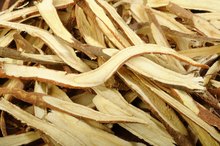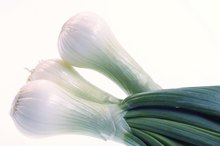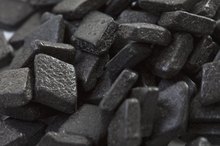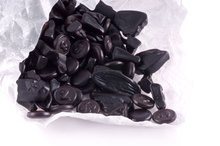What does fact checked mean?
At Healthfully, we strive to deliver objective content that is accurate and up-to-date. Our team periodically reviews articles in order to ensure content quality. The sources cited below consist of evidence from peer-reviewed journals, prominent medical organizations, academic associations, and government data.
The information contained on this site is for informational purposes only, and should not be used as a substitute for the advice of a professional health care provider. Please check with the appropriate physician regarding health questions and concerns. Although we strive to deliver accurate and up-to-date information, no guarantee to that effect is made.
Black Licorice and Stomach Pain
Licorice is an herb that is derived from Glycyrrhiza glabra, a perennial that grows naturally in parts of Europe and Asia. It has been used for medicinal purposes in ancient Greece and Roman times, according to the "Journal of the Pharmaceutical Society of Japan." In modern times, the herb is used for its extract for the treatment of stomach problems and to produce candy, including black licorice.
If you are experiencing serious medical symptoms, seek emergency treatment immediately.
About Black Licorice
Not all black licorice candy is made from Glycyrrhiza glabra. Black licorice also may be made with anise oil, a different herb that has an aroma and flavor that’s similar to licorice. The University of Michigan Health System reports that while anise is an alternative therapy that has been traditionally used for the treatment of indigestion, heartburn and stomach acid, there’s little or no scientific evidence to support these claims 2.
Licorice Compounds
Side Effects of Deglycyrrhizinated Licorice
Learn More
Compounds in herbal licorice have been linked to easing stomach pain. In patients with stomach ulcers, 90 percent experienced an improvement in symptoms and 22 out of 100 were ulcer-free after six weeks of treatment with licorice, according to St. Luke’s Sugar Land Hospital in Texas 3. Deglycyrrhizinated licorice, or DGL -- which is herbal licorice with the compound used for making candy removed – is often used for the treatment of peptic ulcers. Antacids with DGL have been shown in some studies to perform as well as prescription medications for the treatment of ulcers.
- Compounds in herbal licorice have been linked to easing stomach pain.
- Antacids with DGL have been shown in some studies to perform as well as prescription medications for the treatment of ulcers.
Side Effects
In some cases, eating black licorice made with glycyrrhizin could worsen stomach pain or cause breathing difficulties. Eating too much licorice can lead to water retention, also known as edema, and low potassium, or hypokalemia. Symptoms of edema include shortness of breath and chest pain. Hypokalemia can lead to constipation, which causes abdominal discomfort and cramps. Finally, consuming too much candy, even a confection with a known ulcer-curing compound, can cause:
- indigestion
- bloating
- cramps
- nausea
- In some cases, eating black licorice made with glycyrrhizin could worsen stomach pain or cause breathing difficulties.
- Eating too much licorice can lead to water retention, also known as edema, and low potassium, or hypokalemia.
Treatment
Does Fennel Contain Black Licorice?
Learn More
To get relief from abdominal pain, St. Luke's suggests taking herbal licorice rather than its confectionery cousin. You can consume 1 gram to 5 grams of infused dried licorice root three times a day or take 250 milligrams to 500 milligrams of licorice extract three times daily 4. For a peptic ulcer, take 0.4 gram to 1.6 grams of DGL three times a day. Avoid the risk of dangerous side effects If your symptoms persist a week or longer, stop taking licorice and talk to your doctor.
- To get relief from abdominal pain, St. Luke's suggests taking herbal licorice rather than its confectionery cousin.
- For a peptic ulcer, take 0.4 gram to 1.6 grams of DGL three times a day.
Related Articles
References
- Pharmaceutical Society of Japan; A Drug Over the Millennia; January 2000
- University of Michigan Health System; Anise; December 2009
- St. Luke’s Sugar Land Hospital; Licorice; March 2010
- MedlinePlus: Licorice Root
- MedlinePlus; Hypokalemia; May 2011
- NIH National Center for Complementary and Integrative Health. Licorice root. Updated December 1, 2016.
- Raveendra KR, Jayachandra, Srinivasa V, et al. An extract of glycyrrhiza glabra (GutGard)alleviates symptoms of functional dyspepsia: a randomized, double-blind, placebo-controlled study. Evidence-Based Complementary and Alternative Medicine. 2012;2012:1-9. doi:10.1155/2012/216970
- Messier C, Epifano F, Genovese S, Grenier D. Licorice and its potential beneficial effects in common oro-dental diseases. Oral Dis. 2012;18(1):32-39. doi:10.1111/j.1601-0825.2011.01842.x
- Shi Q, Hou Y, Yang Y, Bai G. Protective effects of glycyrrhizin against β2-adrenergic receptor agonist-induced receptor internalization and cell apoptosis. Biol. Pharm. Bull. 2011;34(5):609-617. doi:10.1248/bpb.34.609
- Tsao S, Yin M. Antioxidative and antiinflammatory activities of asiatic acid, glycyrrhizic Acid, and oleanolic acid in human bronchial epithelial cells. J. Agric. Food Chem. 2015;63(12):3196-3204.
- Zhao H, Zhang X, Chen X, et al. Isoliquiritigenin, a flavonoid from licorice, blocks M2 macrophage polarization in colitis-associated tumorigenesis through downregulating PGE2 and IL-6. Toxicology and Applied Pharmacology. 2014;279(3):311-321. doi:10.1016/j.taap.2014.07.001
- Nahidi F, Zare E, Mojab F, Alavi-Majd H. Effects of licorice on relief and recurrence of menopausal hot flashes. Iranian Journal of Pharmaceutical Research: IJPR. 2012;11(2):541-8.
- Hajiaghamohammadi AA, Zargar A, Oveisi S, Samimi R, Reisian S. To evaluate of the effect of adding licorice to the standard treatment regimen of helicobacter pylori. The Brazilian Journal of Infectious Diseases. 2016;20(6):534-538. doi: 10.1016/j.bjid.2016.07.015
- Irani M, Sarmadi M, Bernard F, Ebrahimi Pour GH, Shaker Bazarnov H. Leaves antimicrobial activity of Glycyrrhiza glabra L. Iranian Journal of Pharmaceutical Research: IJPR. 2010;9(4):425-8.
- Penn State Hershey Milton S. Hershey Medical Center. Licorice.
- Omar HR, Komarova I, El-Ghonemi M, et al. Licorice abuse: time to send a warning message. Therapeutic Advances in Endocrinology. 2012;3(4):125-138. doi:10.1177/2042018812454322
- Räikkönen K, Martikainen S, Pesonen A, et al. Maternal licorice consumption during pregnancy and pubertal, cognitive, and psychiatric outcomes in children. Am J Epidemiol. 2017;185(5):317-328. doi:10.1093/aje/kww172
- Consumer Reports. Food and drug interactions you need to know about. Updated November 4, 2018.
- Winchester Hospital. Library. Updated April 11, 2011.
- Consumer Reports. How to choose supplements wisely. Updated October 30, 2019.
- FDA. Black licorice: Trick or treat? Updated November 6, 2017.
Writer Bio
Shannon Marks started her journalism career in 1994. She was a reporter at the "Beachcomber" in Rehoboth Beach, Del., and contributed to "Philadelphia Weekly." Marks also served as a research editor, reporter and contributing writer at lifestyle, travel and entertainment magazines in New York City. She holds a Bachelor of Arts in literature from Temple University.









